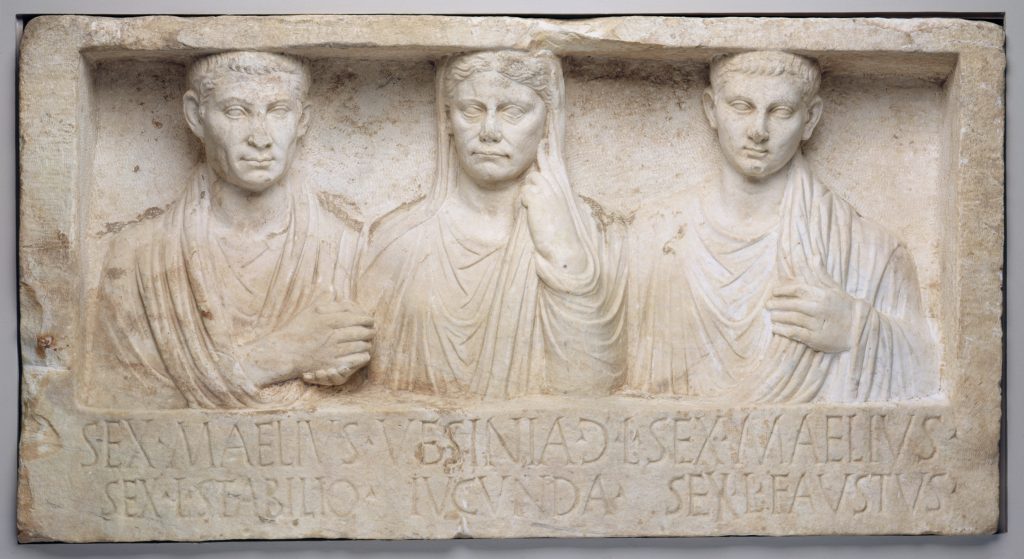Monumento funerario a Sexto Maelio Stabilio, Vesinia Iucunda y Sexto Maelio Fausto (obra de arte)
Información sobre la obra de arte
Key Ideas
- Este funerario (relacionado con el entierro) formaba parte originalmente de una tumba de piedra que se encontraba a lo largo de una carretera principal en las afueras de Roma. Se trata de un relieve relieve, es decir, una escultura con figuras figuras que sobresalen del fondo sin dejar de estar unidas a él.
- It depicts three human figures: a man, a woman, and a young man or boy. The letter L at the bottom of the work identifies these figures as freed people; this letter stands for libertus, meaning “freedman” and liberta, meaning “freedwoman.”
- El hombre de la izquierda y la mujer aparecen dándose la mano, lo que representa su matrimonio. El joven de la derecha es probablemente el hijo de la pareja, nacido cuando aún eran esclavos.
- El padre y el hijo llevan cada uno una toga, un tipo de prenda que sólo podían llevar los ciudadanos romanos. La madre, representada con un velo nupcial, se lleva la mano izquierda a la cara. Este gesto sugiere su conformidad con los valores tradicionales romanos.
Más información
This marble relief was carved to fit into the front of a stone tomb that stood along a major road outside Rome. The Latin inscription, or writing carved into the stone, identifies the three figures as Sextus Maelius Stabilio, Vesinia Iucunda, and Sextus Maelius Faustus. Slavery was common in ancient Roman society. When an enslaved person was released from slavery through a process called manumission, they took on the family name of the person who had enslaved them. The father (Stabilio) and the son (Faustus) depicted on this monument have the name of their former enslaver, Sextus Maelius. The mother (Iucunda) has the name Vesinia from her former enslaver. The letter L in the inscription stands for libertus, meaning “freedman,” and liberta, meaning “freedwoman.” Freed individuals did not have all the privileges of citizenship, but they were still considered citizens and had the right to vote, trade, and obtain local religious leadership roles.
The symbols of marriage in this relief reflect the importance of family during the reign of Augustus (27 BCE to 14 CE). The handshake shared by the man and the woman identifies them as husband and wife. Stabilio wears a toga, a garment that could only be worn by Roman citizens. Iucunda wears a bridal veil and betrothal (engagement) ring and holds her left hand to her face. This traditional gesture of modesty represents her conventional Roman morals and citizenship. The younger man on the right is most likely the couple’s son, born to them while they were enslaved. Any children born to the married couple after they were freed would have received full rights as a Roman citizen.
Reliefs like this one were often commissioned by recently freed enslaved people and their families. The reliefs may have served as a way for freed individuals to present themselves with the social identity and family relationships that were denied to them during slavery.
tags: symbolism, ancient Rome
Recursos adicionales
Recursos para los profesores:
- Lea un artículo sobre la esclavitud en la antigua Roma.
- Lea un artículo para saber cómo se representaba visualmente el matrimonio, incluso en los monumentos funerarios romanos.
- Explora otros monumentos funerarios romanos.
Recursos para los estudiantes:
- Vea un vídeo sobre la vida después de la esclavitud en la antigua Roma.
- Vea un vídeo para saber cómo vestían los antiguos romanos.
- Lea un artículo sobre los diferentes tipos de monumentos funerarios griegos y romanos antiguos.

